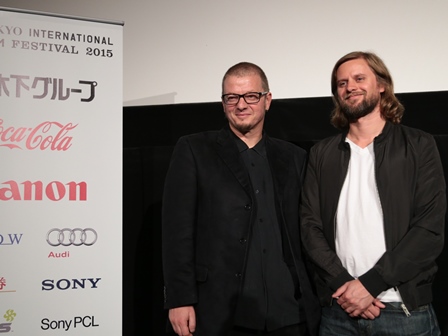
In popular culture the bureaucracy is often presented as an inconvenience, but in Rodrigo Plá’s social-minded thriller it becomes something that is actually deadly, an implacable “monster.” At issue is the Mexican medical establishment, which is in thrall to the insurance industry, a public-private entity whose profit-oriented aims prevent it from carrying out its mission, which is to provide health care to everyone. As a result, doctors are not always able to carry out their mission, which is to treat illness and “not do any harm.”
The movie is structured as an explication of a court case involving a woman (Jana Raluy) who resorts to violence when her terminally ill husband is refused treatment to ease his suffering because his doctor, at the behest of the man’s insurance company, won’t approve such treatment. The wife brings her son along when she goes to confront the doctor, who won’t return her phone calls. After she follows him to his home, she produces a gun and points it at the doctor and his wife, demanding that he review her husband’s case. Eventually, this tense situation is replicated up the chain of command, all the way to the office of the CEO of the insurance company. She learns a lot on the way, as does the viewer, but the viewer also knows how this tragedy is going to end, because even a woman with a gun can’t destroy a monster with a thousand heads.
Unlike the Denzel Washington vehicle, John Q., which addressed the same problem in a similar way, Plá’s film is brisk (75 minutes) and less sentimental than you might expect it to be. As the director explained after the press screening, the screenplay is based on a novel written by his wife that she adapted from a story idea he came up with. By making the story into a novel first, he could set up the plot from various points of view that later made it easier to translate the original idea into visual terms. “The main focus is the main character, the woman with the gun, Sonia Bonet,” he said. “but everyone on screen has a point of view.” This is, in a sense, the thousand-headed monster of the title, a system that creates the tragedy that unfolds. Plá is clear about his position. “Doctors and insurance companies will do anything to make money,” he said. “And this is in Mexico, a Catholic society.”
One reporter asked about the son and his role in the film. Plá answered that the teenage boy’s perspective develops as the movie progresses, and thus “the audience’s perspective develops also. The boy changes in relation to his reality from moment to moment.” Switching from Spanish to English in order to get his point across more directly and quickly, Plá said, “The relationship between the mother and the son was very important, especially their response to the situation of the sick father. But I didn’t want to push my opinion on the viewer, or their opinion, either. That’s why I kept changing the viewpoint via the court testimony by the various witnesses.” In other words, when you have one thousand subjective points of view, you end up with one overall objective point of view. “Inevitably, I want the viewer to be the judge.”
Another reporter remarked that Sonia was “very tough” and asked if all Mexican women are that tough. Plá said that he would “never stereotype women in that way,” and, in fact, he and his wife wanted to depict Sonia as a person “who has made some mistakes” and insisted “we are not saying you should take the law into your own hands.” Someone asked if the director himself would resort to such extremes if a loved one was suffering. “Of course, I love my wife,” he said, but left it at that.
If the movie has an overarching theme, it’s a local one. “Mexico has many problems,” Plá said. “More than 160,000 violent killings a year. It’s quite frightening, especially when you think the government is doing nothing. And that feeling comes through in this movie. If you are a citizen and have a problem with your neighbor or somebody else, who do you turn to? There’s no solution.”
[Philip Brasor]






















